The Visionary CEO’s Guide to Sustainability

한눈에 보기
- In our global study, roughly 60% of consumers say their concerns about climate change have increased in the past two years.
- The best companies will develop solutions that help consumers live more sustainably, not just buy more sustainably.
- Companies can’t market “sustainability” as a single concept or address consumers as a monolithic group, but value can be created by targeting specific customer segments with category-relevant claims.
- Packaging and recyclability have surfaced as key concerns for consumers.
This article is part of Bain's 2024 CEO Sustainability Guide
The last year has given consumers much to worry about. From wars to heightened political tensions to lingering inflation, new reasons for unease have gained mindshare around the world. But these worries have barely dislodged a major issue in consumers’ consciousness: Concerns about sustainability remain high and are competing with cost of living, political, and household finance worries. This comes at a time when many global CEOs are turning their attention to pressing matters such as disruptive AI technology, the need for growth, and geopolitical uncertainty.
Even as CEOs deal with competing priorities, the message from people around the world in our second annual global study is clear. Among the nearly 19,000 consumers in 10 countries who participated in our recent survey, roughly 60% say that their concerns about climate change have increased over the past two years, often sparked by personal experience of extreme weather (see Figure 1)—the same as when we asked the question last year. In a broad-ranging study that included a survey, in-depth interviews, and shopping trips with global consumers, many told us that they want to live sustainably and that they believe their personal actions make a difference (see Figure 2).
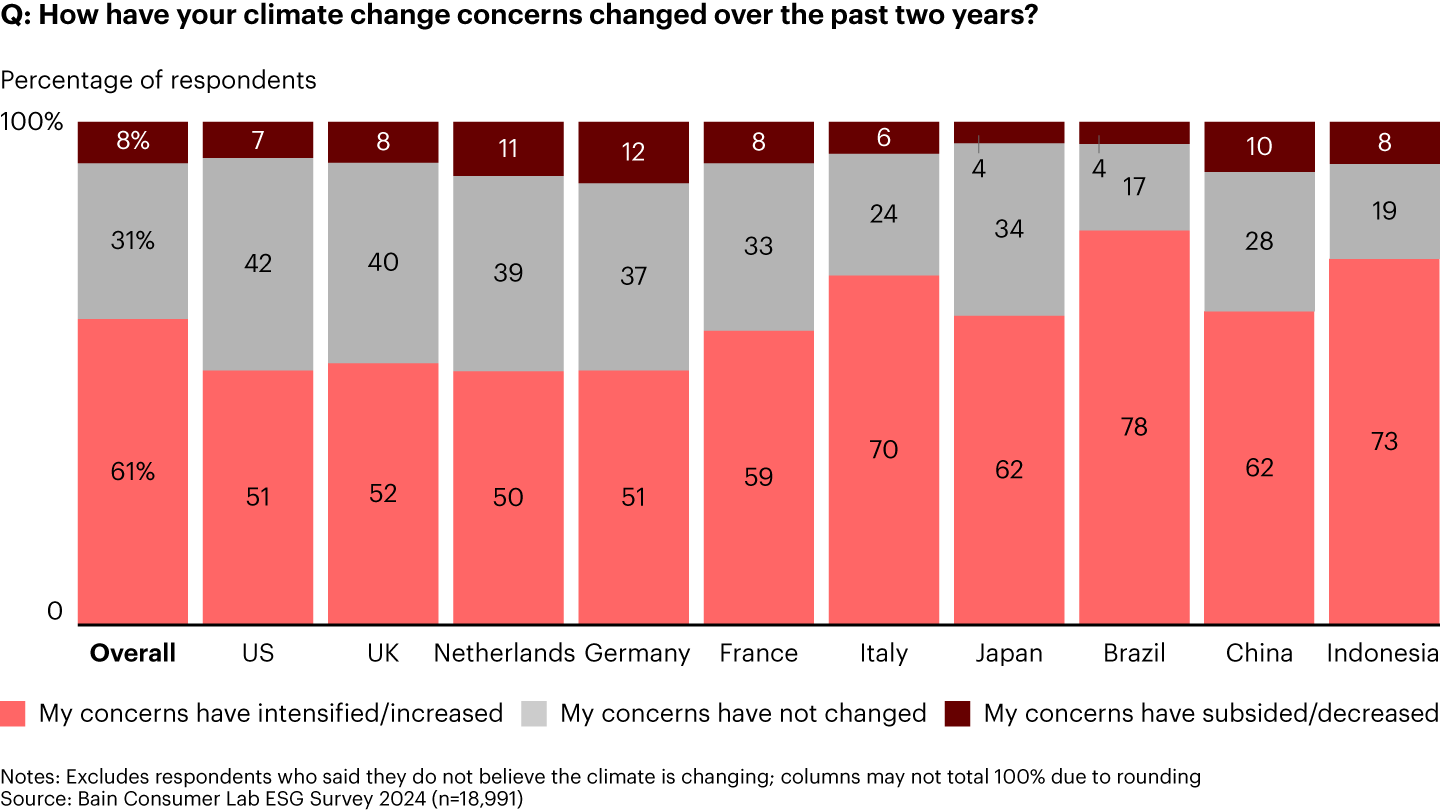

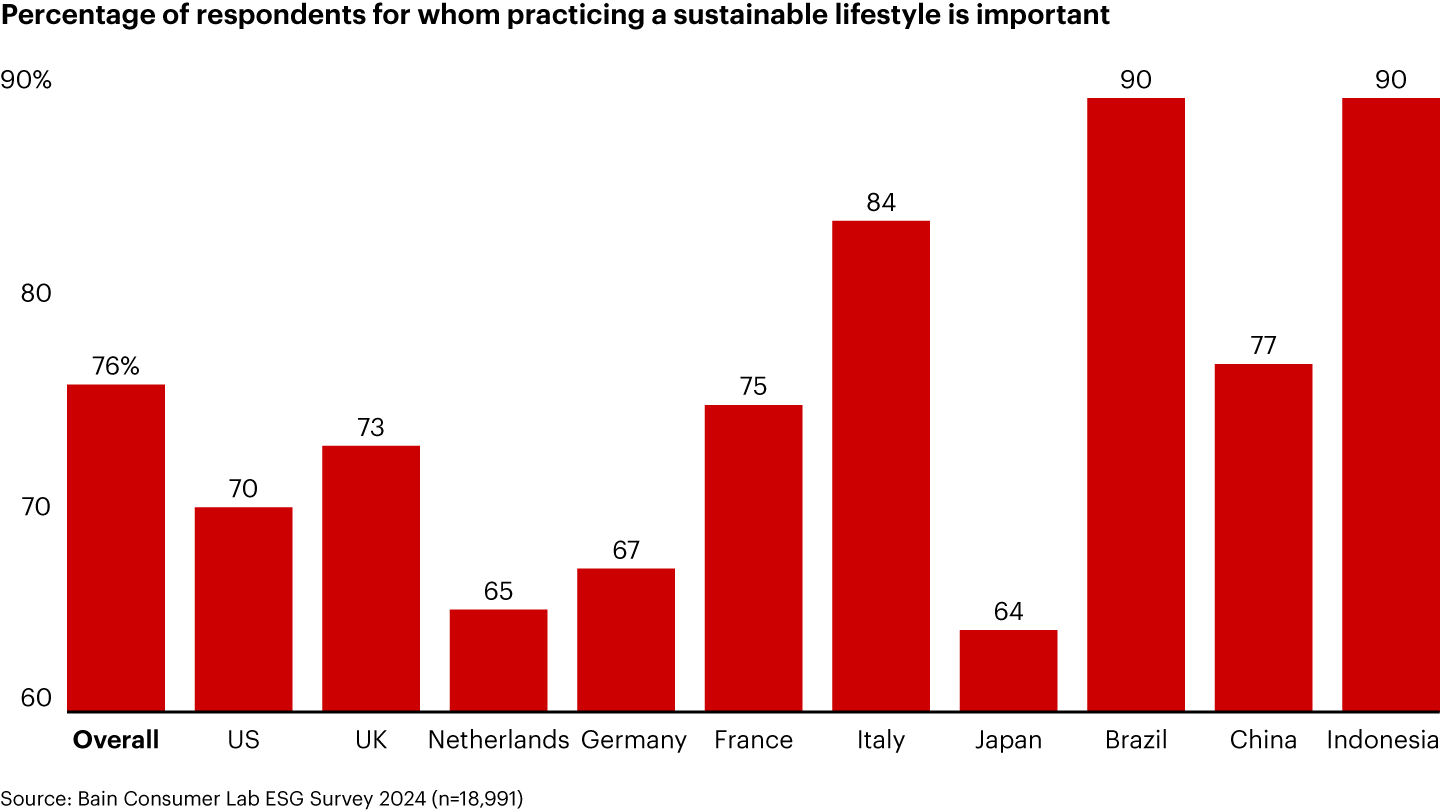

However, consumers have trouble figuring out how to live sustainably and look to brands and retailers, in addition to government, to help them. This opens up opportunities for companies that can support consumers’ continuing quest for a sustainable lifestyle. But it also surfaces some fundamental issues that raise the stakes for businesses in the current economic climate.
For example, there is a consistent view in developed markets that living sustainably is inherently more expensive (see Figure 3). That isn’t always true. Some consumers, while trying to save money, are adopting habits that also happen to be more sustainable, such as driving less, buying secondhand clothing, and, in some cases, actively cutting down on meat and dairy (see Figure 4). But the common perception that a sustainable lifestyle is expensive poses a challenge for brands, especially amid intensified cost-of-living worries. Conversely, consumers in some fast-growing markets believe that living more sustainably would actually cost them less. The frugal behavior they associate with sustainability could lead to an overall reduction in demand and consumption, complicating companies’ growth plans.
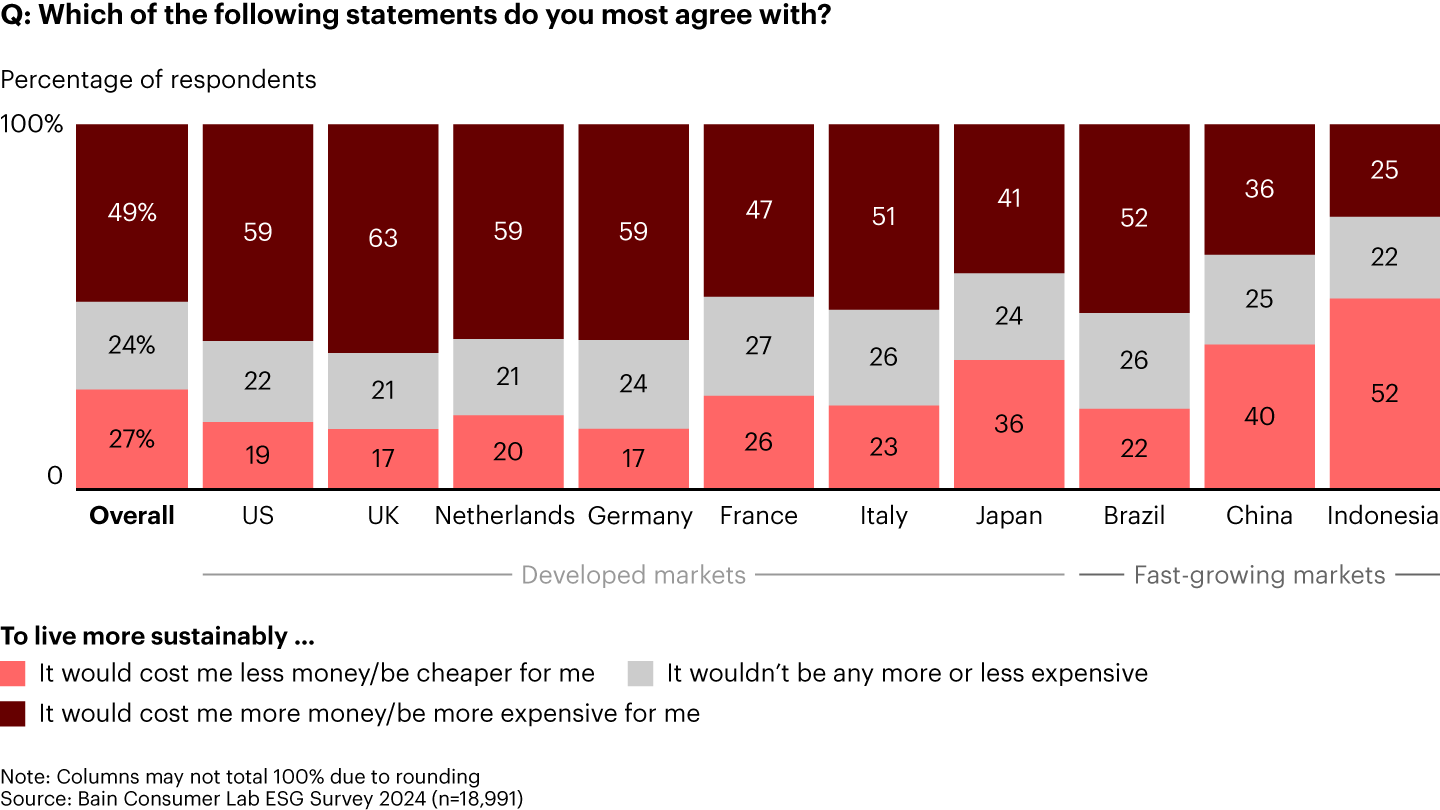

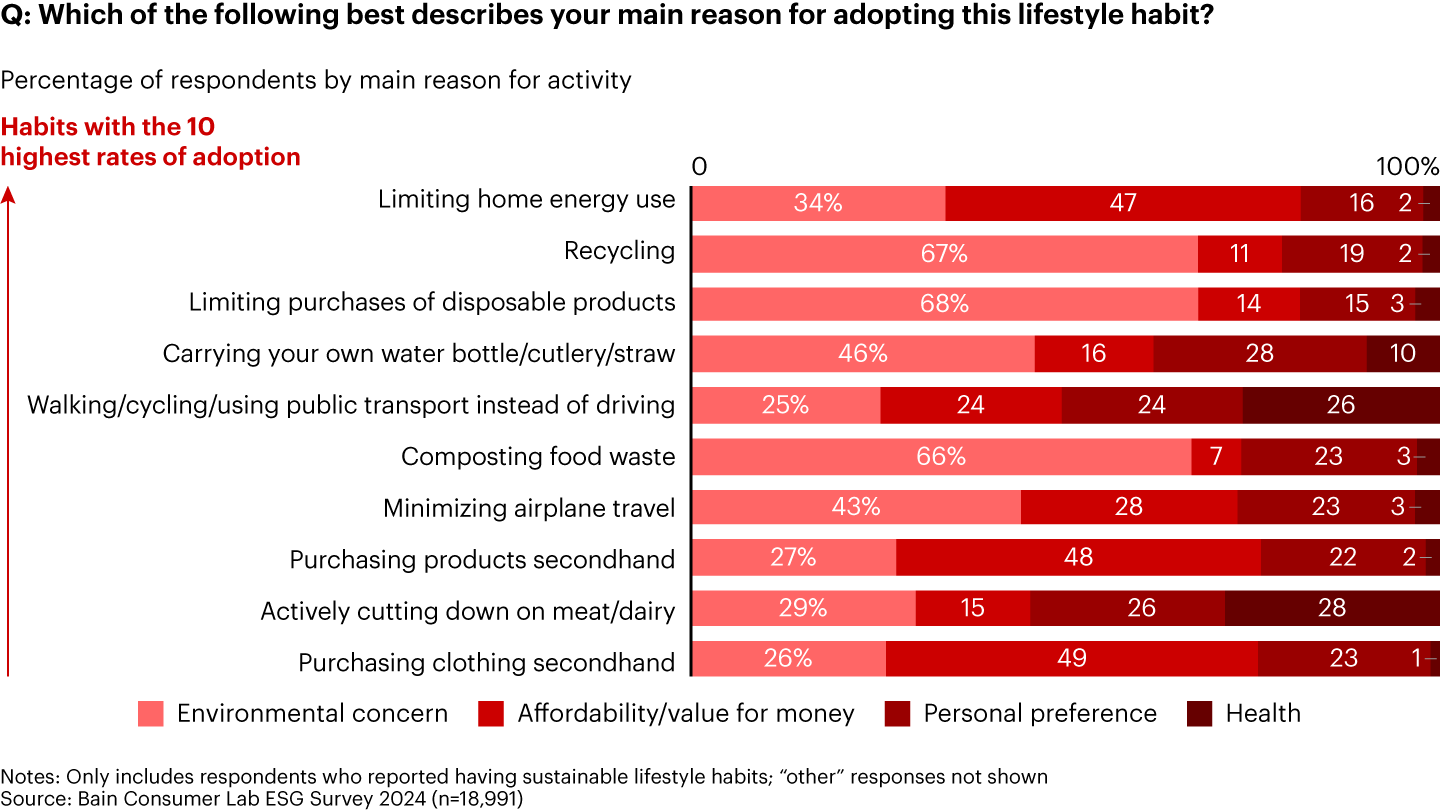

The need to deaverage consumers
Just as these beliefs vary by geography, approaches to sustainable lifestyles diverge based on factors ranging from cultural norms to political leanings. Our research also helped us identify how people value different sustainability attributes across product categories (see Figure 5).
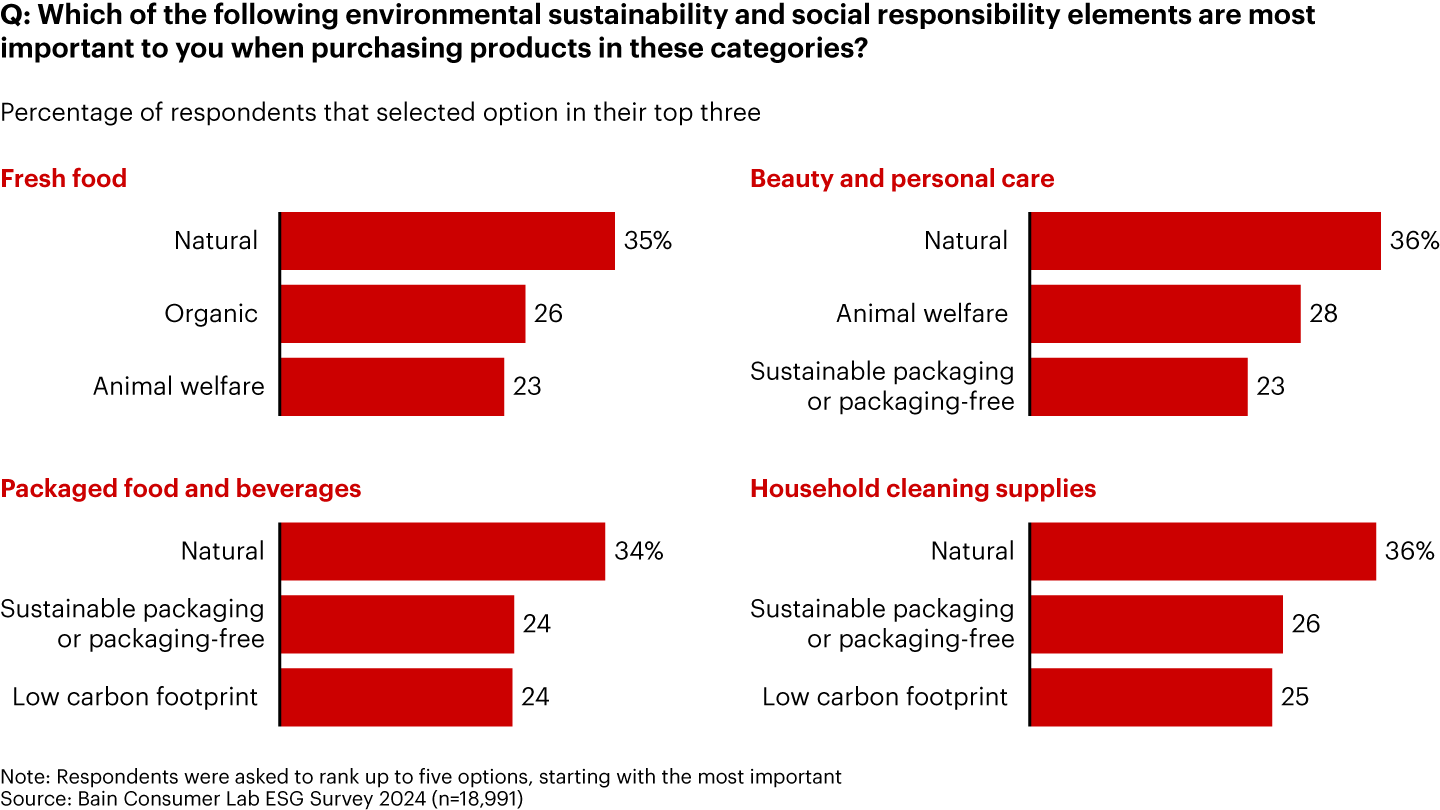

The division extends to where consumers learn about sustainability. Gen Zers in the US turn to a variety of sources for information about sustainability, with 37% relying on social media—the predominant source for them. Only 3% of US baby boomers rely on social media. There’s also a division among consumers in the types of businesses they trust to sell them sustainable products. In most countries, consumers are more likely to trust smaller businesses, but in China and Japan, big companies are more trusted. And consumers are more likely to pay a premium in certain categories with certain benefits. In the US, for example, consumers say they’re willing to pay up to 10% more for products that have minimal environmental impact and up to 15% more for products that have health benefits.

Ten Takeaways from Our 2024 Sustainability Survey of Consumers
We asked nearly 19,000 consumers globally about their efforts to live a sustainable lifestyle. Here’s what’s changed—and what hasn’t—since last year.
This means that it isn’t effective for companies to market “sustainability” as a single concept or to target consumers as a monolithic group. Businesses need to understand what different consumer segments are after on a category-by-category basis. Yet appealing to specific sustainability priorities means taking a targeted approach to product development and marketing that runs counter to the movement toward simplicity. We call this smart complexity: striking the right balance between agility and scale to maximize the benefits of streamlining without sacrificing responsiveness to consumer needs.
Indeed, companies need a more flexible and agile supply chain that allows for more variations—enabling, for example, flexible modular designs and packaging with targeted messages. Smart complexity also allows companies to target consumers based on their specific sustainability needs. And with the right products in hand, some companies have begun relying on digital and AI tools to experiment with and customize their messaging to consumers.
As they develop new products and services, the best companies will consider how those offerings will help consumers live more sustainably, not just buy more sustainably. It’s one thing to introduce a greener version of an existing product at a higher price point than many consumers are willing to pay. There’s much more value to be created if that new product meets other key purchasing criteria—for example, if it saves the consumer time, helps lower their energy bill, or improves their health. Take wool dryer balls, which serve as a chemical-free alternative to dryer sheets or fabric softener while also cutting down on drying time and energy costs.
Consumers say that brands and retailers play a big role in their sustainability journey: 28% indicate that awareness campaigns by brands and retailers prompted them to start buying more sustainable products. As a sign of retailers’ part in the equation, 33% of consumers report that they started buying sustainable products because they became available in the places they shop (see Figure 6).


Consider the full product life cycle
This year’s research also highlights the growing importance of packaging in consumers’ perception of sustainability (see Figure 7). This finding raises the pressure on companies (many of which report being behind schedule to meet 2025 recycling targets) both for recycled packaging and for the recyclability of their packaging. Consumers determine whether or not packaging is sustainable primarily from the perspective of what happens to it once they are ready to dispose of it—for example, if it is recyclable. In fact, consumers tell us that the ability to recycle packaging is significant to them and that the choice of material and use of recycled content also matter (see Figure 8).


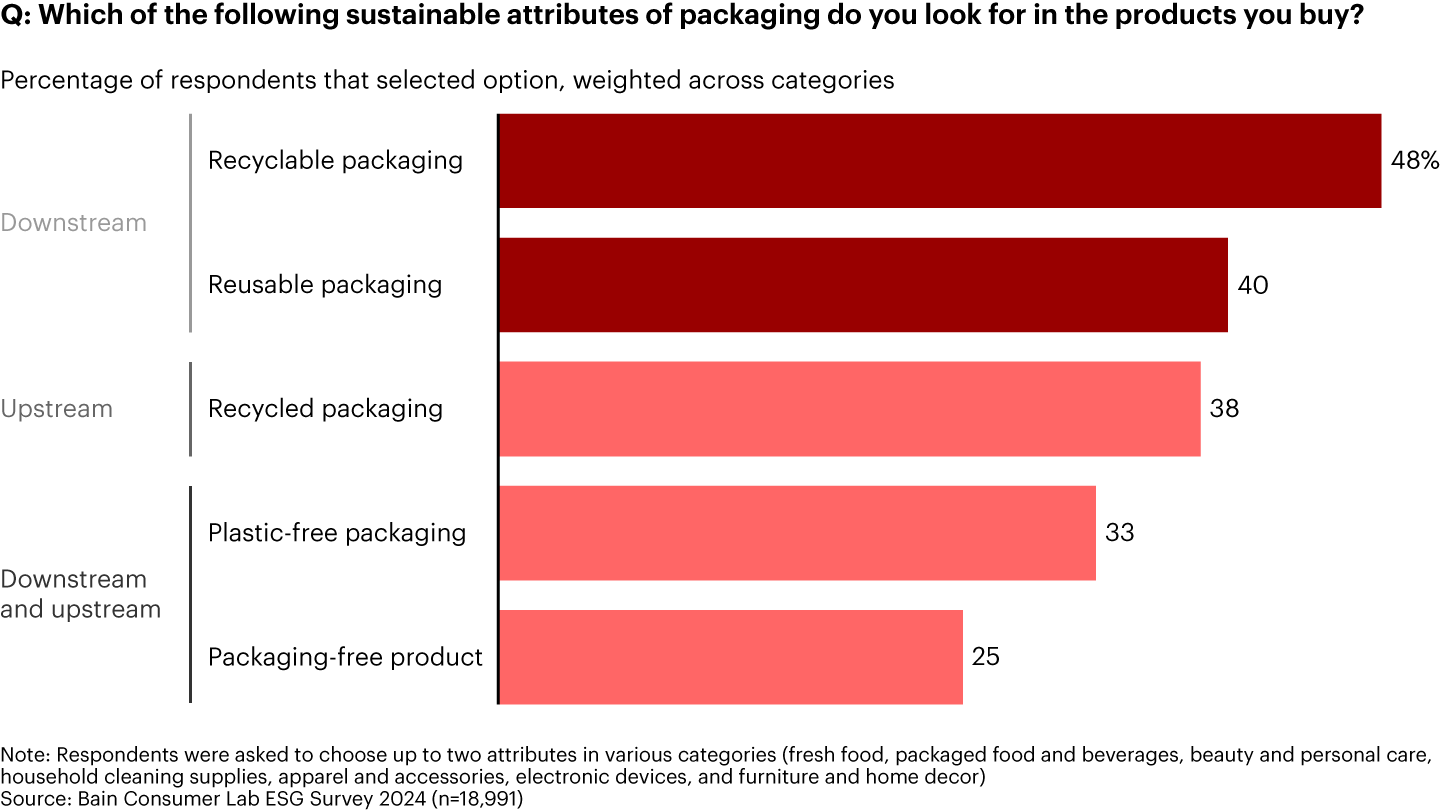

Because consumers care about what happens to their waste, companies can distinguish themselves by leaning into the entire packaging value chain, including the downstream segment. As they do, they must face the big question of how to finance the collection, sorting, and recycling infrastructure, especially in less developed markets. They also must tackle the challenge of educating consumers. For example, consider that most surveyed consumers believe that the production of single-use, virgin glass has a lower carbon footprint than plastic, yet the opposite is true. Adding to the complexity for global companies, there’s a wide disparity in recycling regulations and infrastructure among markets.
Unlocking the challenges
What to do? We see five critical steps.
Size the opportunity to seize the opportunity. Brands can help consumers in their sustainability quest and spur profitable volume growth by drawing on their well-honed ability to segment and target consumers. Companies need to be willing to invest in identifying and developing products that meet untapped sustainability needs—and create the right messaging. That means determining where people are willing to pay more (and their limits) and where the company can gain share, and then taking a test-and-learn approach to innovation and marketing.
Organize for results. Many traditional companies’ operating models are not set up to serve the needs of sustainability-minded consumers. A simple example of the disconnect: The costs of developing new sustainable formats or purchasing more sustainable input materials are often assumed by supply chain and operations. However, these teams are detached from marketing and an understanding of what consumers value. Too often, the costs and benefits are misaligned, and companies miss opportunities to use sustainability to gain value with consumers.
Prepare to manage complexity. Be ready to acknowledge the fragmented market, both in production and in marketing. Companies need a more agile supply chain to make more variations, for example. And in many situations, marketing complexity arises from the new imperative to use different messaging for different consumer segments. For example, a plant-based spread could be promoted with one set of messages to a consumer group whose primary concern is animal welfare and with completely different messages to those who are focused on healthy food.
Tackle the packaging challenge. Not only do companies need to make packaging sustainable, they need to communicate that value to consumers while also educating them about the nuances of material choices. They also can work to solve the downstream piece of the puzzle, addressing the recycling infrastructure where it’s necessary.
For example, the best companies will avoid making packaging out of multiple different materials so that it needs to be disassembled to recycle. Nestlé is actively working in this direction. The company’s Purina brand launched its first designed-to-be-recyclable mono-material pet food pouch in 2022, and Nescafé debuted its first refillable paper pouch for coffee in 2024—all part of Nestlé’s promise to introduce reusable or recyclable packaging by 2025. (The Consumer Goods Forum’s Golden Design Rules for plastic packaging are an industry standard in packaging design.)
Brands also can ensure that information about packaging is transparent. Being clear about recyclability, for example, makes it easy for consumers to make the right disposal choice. Together, retailers and brands can reduce confusion and help consumers understand what the sustainable options are and why.
Build channel partnerships. Companies can help speed consumers’ paths to achieving a sustainable lifestyle by forging the right partnerships across the value chain. That includes brand owner and retailer collaboration. With so many consumers telling us that accessibility is one of the key barriers preventing them from purchasing sustainable products, companies can collaborate to ensure prominent product placement and encourage new behavior in areas like refills or packaging returns. For example, The Perfume Shop partnered with L’Oréal to launch the UK’s first multi-brand fragrance refill station, including YSL, Prada, Armani, Mugler, and Lancôme brands.
Will such moves spur consumers to action? If we’ve learned anything about sustainability over the years, it’s that consumers will change their behavior if stakeholders make it easier for them or provide incentives. Despite their many other worries, consumers tell us they still are concerned about living and shopping sustainably. They have different preferences and even different definitions of sustainability. But they are uniform in their need for others—governments, industry organizations, brands, and retailers—to pave the way.